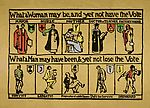 Suffragette propaganda poster
Suffragette propaganda poster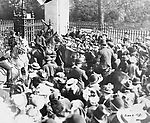 Suffragette riot at Buckingham Palace 1914
Suffragette riot at Buckingham Palace 1914 Suffragette being arrested 19th Nov. 1914
Suffragette being arrested 19th Nov. 1914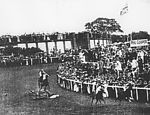 Emily Davison throwing herself in front of the King's horse at the 1913 Derby
Emily Davison throwing herself in front of the King's horse at the 1913 Derby Cat and Mouse Act poster
Cat and Mouse Act poster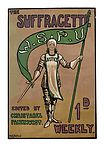 Poster advertising the 'Suffragette' newspaper
Poster advertising the 'Suffragette' newspaper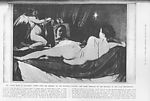 Velasquez slashed by suffrage protesters
Velasquez slashed by suffrage protesters Lloyd George's house bombed
Lloyd George's house bombed

SUFFRAGISTS - people who support suffrage, the right or privilege of voting.
During the nineteenth century a movement developed to support universal suffrage in Britain. The only members of society who could vote during the mid 19th century were male, aged 21 years and over, owning or renting property of £10 per year.The Parliamentary Reform Act of 1832 was seen as a missed opportunity. It increased the number of middle class men who could vote, but did not include women or working class men. This angered many sections of society, and groups began to organise to campaign for adult suffrage.
In 1865 a group of women formed the Kensington Society. Most of the women in the discussion group were unmarried and striving to achieve qualifications to enable them to pursue a career. Following one discussion evening, they decided to petition parliament to grant women the right to vote. Unfortunately they were defeated, 73 votes against 196. Their disappointment led them to form The London Society for Women’s Suffrage. Many other societies formed around the country, and in 1887 many of these joined together to form the National Union of Women’s Suffrage Societies. Lydia Becker, who had been active in the Manchester branch, was made president. Following Becker’s death 3 years later, Millicent Fawcett took over the presidency.
The N.U.W.S.S. campaigned for a wide variety of causes in many ways. They organised meetings and petitions, published literature, wrote to politicians and supported other women campaigners. Fawcett believed in the power to change through persuasion. She argued that women who had money and were able to employ men as gardeners, for example, were in the ridiculous position of not being able to vote themselves, while the men they employed could. Fawcett also argued that women who worked paid the same tax as men who worked, but the men could vote and the women could not. Though Fawcett managed to convince many people of her cause, many remained unconvinced. "Political power in many large cities would chiefly be in the hands of young, ill-educated, giddy, and often ill-conducted (badly behaved) girls." (Frederick Rylands, 1896, History Learning Site). This type of comment angered many women, who were frustrated by the lack of progress made in their campaigns.
In 1903 a group in Manchester broke away from the N.U.W.S.S. and formed the Women’s Social and Political Union, led by Emmeline Pankhurst. This group no longer felt prepared to be restricted by the constitutional methods of the N.U.W.S.S. The members of the W.S.P.U. were given the name "suffragettes" by the Daily Mail newspaper in 1906, using the term to refer to the more militant activists of the suffrage movement. Emmeline believed that if men would not listen to reasoned, peaceful campaigning, then women would have to use force to win the right to vote. The measures used by the women became more extreme with time, as frustration with the lack of legislative change grew. The W.S.P.U.’s more extreme campaigns included damage to public buildings, including burning churches, attacks on politicians and other public figures, disrupting the work of Parliament, and when arrested often going on hunger strike.
There was rising dissatisfaction amongst some members of the W.S.P.U., believing that the Pankhursts were having too much influence, and were making decisions without consulting other members of the group. In 1909 the Women’s Freedom League was set up by around 70 members of the W.S.P.U. The W.F.L. were a totally non-violent group, who though arrested for demonstrating, were fiercely critical of some of the W.S.P.U.’s actions. The W.F.L. set up a newspaper, "The Vote", which allowed them to inform the public of their beliefs and campaigns. They soon had massive membership of 4,000, with branches across the country.
The more militant action of some groups began to lead to an increase in arrests. In July 1909 Marion Wallace Dunlop was arrested and sentenced to one month in the second division (In the second division conditions and privileges for prisoners were not as harsh as for criminals in the third division). She protested that she should be classed as a political offender, and when this was denied to her, she went on hunger strike. After a 91-hour fast she was released. This form of defiance was used by many other suffrage prisoners. The government was concerned by the threat of hunger strike, as they recognised that it could gain support for the women. Reports of forced feeding, locally at Winson Green Prison, Birmingham, began to make the headlines. Forced feeding had previously only been used when dealing with the mentally ill, and the use of the same treatment for these middle class women outraged much of society. It was however adopted as the treatment given to hunger strikers for the next 4 years.
W.S.P.U. members often wore a badge, scarf, or sash in the colours of purple for dignity, white for purity and green for hope. Such an obvious act of defiance against government policy was seen as being unladylike, and attracted abuse from anti-suffrage sympathisers.
November 18, 1910, saw a group of hundreds of women, some as old as 70, march to parliament in protest against the Government’s attitude towards women's suffrage. They struggled for hours to get past the police, but were treated with no respect. They were jostled and pushed by the police until many fainted. The day became known as "Black Friday" and the actions of the police meant that sympathy for the women’s cause grew.
The Government hurried through new legislation, in 1913, which became known as the "cat and mouse act". It allowed them to release prisoners once they became seriously ill through lack of food. They then monitored the women, and once they had regained their strength, rearrested them to finish their sentence.
The events of June 4, 1913, caught the public’s imagination. At the Epsom Derby, attended by King George V, suffragette Emily Wilding Davison ran on to the course, falling in front of the King’s horse. She died four days later from her injuries, and her funeral service attracted large crowds. She became one of the most famous suffragettes, and a martyr for the cause.
July 26th 1913 saw a mass rally organised by the N.U.W.S.S. to demonstrate to the Government the number of women who wanted the vote, and the extent of the support they received. Meetings were held throughout Britain in the weeks leading up to the rally which ended in Hyde Park, where an estimated 50,000 supporters gathered peacefully. The Times reported, “On Saturday the pilgrimage of the law abiding advocates of votes for women ended in a great gathering in Hyde Park attended by some 50,000 persons. The proceedings were quite orderly and devoid of any untoward incident. The proceedings, indeed, were as much a demonstration against militancy as one in favour of women's suffrage. Many bitter things were said of the militant women.”
There was concern that the militant actions of the W.S.P.U. could harm the cause of the more peaceful N.U.W.S.S. Millicent Fawcett and the N.U.W.S.S. admired the courage shown by the suffragettes . However the anti suffrage movement used the militant actions of the suffragettes to undermine the cause, and highlight why women shouldn’t be allowed to vote. As the militant actions started to turn some sympathisers away from supporting universal suffrage, some publicity defined the difference between the two branches of suffrage campaigning.
The militancy of the W.S.P.U. concerned many of its members. The shop window smashing policy adopted led to the W.S.P.U. leaders being arrested. Christabel Pankhurst fled to France, leaving other leaders, Mr and Mrs Pethick-Lawrence, to suffer a nine month imprisonment, and to be fined to cover the cost of the damage caused. This seems to be rather unjust, as they had spoken out against the more violent policies of the W.S.P.U., but had been ignored by the Pankhursts. Upon their release from prison the Pethick-Lawrences expressed concerns that the militant actions may be harming the cause, and were so expelled from the organisation. In 1914 Emmeline and Christabel Pankhurst also expelled Sylvia Pankhurst. She had disagreed with many of their strategies. She was anti-violence, and did not agree with their abandonment of socialist values, when they began to show favour towards limited franchise in order to gain middle class support. The East London Federation of Suffragettes, a group she founded in 1912 with working class women, continued to campaign for universal suffrage and socialist values, throughout the war. Their paper, "The Women’s Dreadnought" (later, "The Worker’s Dreadnought"), was distributed nationwide, and carried their message for wider social reform.
With the outbreak of World War One in 1914 came a call by many suffrage groups to halt their campaigns, and turn their energies to supporting the war effort. The Pankhursts offered unquestioning support to the war effort, and called for all members of the W.S.P.U. to do the same. They changed the name of their paper from "The Suffragette" to "Britannia". The W.F.L. did not agree with the suspending of action by the W.S.P.U. and N.U.W.S.S., and throughout the war supported the Women’s Peace Council, whose members campaigned for a negotiated peace.The end of the war, in 1918, saw women over the age of 30 gain the right to vote, and also allowed them to stand for Parliament as MPs in the same year. This angered many younger women as the right to vote was seen as thanks to women for their work during the war years, but much of this work was done by the younger unmarried women, who were not the ones given the right to vote. It took another 10 years of campaigning before, in 1928, women were finally given the same suffrage rights as men.
Adult Suffrage was finally granted in Britain in 1928, 25 years after New Zealand, the first country to pass the legislation. It is important to recognise that there are still women throughout the world, who have few rights, and that the penalty they suffer for speaking out and campaigning for a fair society can be torture and death.
Rollover the captions in the box to see the available images in thumbnail format, click the caption to see the full-size image
| Reference: | 721 |
| Keywords: | |
| Archive Ref: | |
| Updated: | Wed 12 Mar 2008 - 1 |
| Interpretation written by | Jenny Ermoyenous |
| Author's organisation | Curatorial |
| Organisation's website |